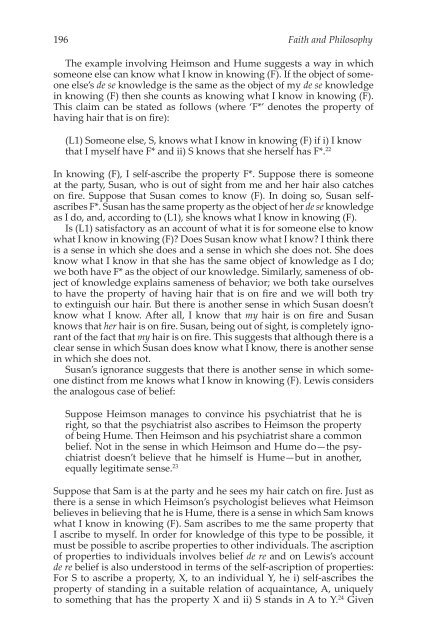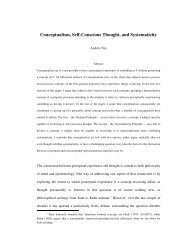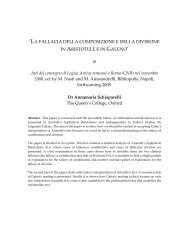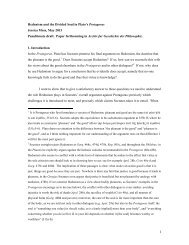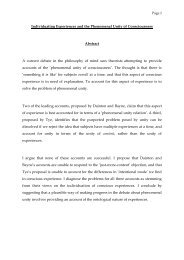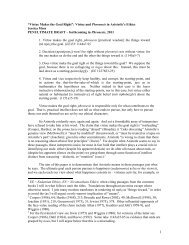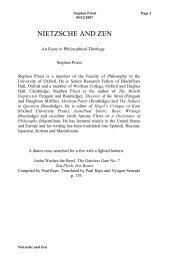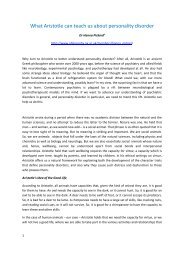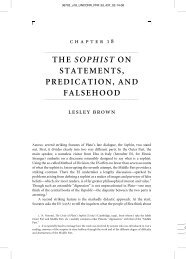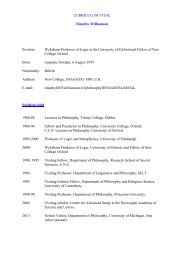de se knowledge and the possibility of an omniscient being
de se knowledge and the possibility of an omniscient being
de se knowledge and the possibility of an omniscient being
Create successful ePaper yourself
Turn your PDF publications into a flip-book with our unique Google optimized e-Paper software.
196 Faith <strong><strong>an</strong>d</strong> Philosophy<br />
The example involving Heimson <strong><strong>an</strong>d</strong> Hume suggests a way in which<br />
someone el<strong>se</strong> c<strong>an</strong> know what I know in knowing (F). If <strong>the</strong> object <strong>of</strong> someone<br />
el<strong>se</strong>’s <strong>de</strong> <strong>se</strong> <strong>knowledge</strong> is <strong>the</strong> same as <strong>the</strong> object <strong>of</strong> my <strong>de</strong> <strong>se</strong> <strong>knowledge</strong><br />
in knowing (F) <strong>the</strong>n she counts as knowing what I know in knowing (F).<br />
This claim c<strong>an</strong> be stated as follows (where ‘F*’ <strong>de</strong>notes <strong>the</strong> property <strong>of</strong><br />
having hair that is on fire):<br />
(L1) Someone el<strong>se</strong>, S, knows what I know in knowing (F) if i) I know<br />
that I my<strong>se</strong>lf have F* <strong><strong>an</strong>d</strong> ii) S knows that she her<strong>se</strong>lf has F*. 22<br />
In knowing (F), I <strong>se</strong>lf-ascribe <strong>the</strong> property F*. Suppo<strong>se</strong> <strong>the</strong>re is someone<br />
at <strong>the</strong> party, Sus<strong>an</strong>, who is out <strong>of</strong> sight from me <strong><strong>an</strong>d</strong> her hair also catches<br />
on fire. Suppo<strong>se</strong> that Sus<strong>an</strong> comes to know (F). In doing so, Sus<strong>an</strong> <strong>se</strong>lfascribes<br />
F*. Sus<strong>an</strong> has <strong>the</strong> same property as <strong>the</strong> object <strong>of</strong> her <strong>de</strong> <strong>se</strong> <strong>knowledge</strong><br />
as I do, <strong><strong>an</strong>d</strong>, according to (L1), she knows what I know in knowing (F).<br />
Is (L1) satisfactory as <strong>an</strong> account <strong>of</strong> what it is for someone el<strong>se</strong> to know<br />
what I know in knowing (F)? Does Sus<strong>an</strong> know what I know? I think <strong>the</strong>re<br />
is a <strong>se</strong>n<strong>se</strong> in which she does <strong><strong>an</strong>d</strong> a <strong>se</strong>n<strong>se</strong> in which she does not. She does<br />
know what I know in that she has <strong>the</strong> same object <strong>of</strong> <strong>knowledge</strong> as I do;<br />
we both have F* as <strong>the</strong> object <strong>of</strong> our <strong>knowledge</strong>. Similarly, sameness <strong>of</strong> object<br />
<strong>of</strong> <strong>knowledge</strong> explains sameness <strong>of</strong> behavior; we both take our<strong>se</strong>lves<br />
to have <strong>the</strong> property <strong>of</strong> having hair that is on fire <strong><strong>an</strong>d</strong> we will both try<br />
to extinguish our hair. But <strong>the</strong>re is <strong>an</strong>o<strong>the</strong>r <strong>se</strong>n<strong>se</strong> in which Sus<strong>an</strong> doesn’t<br />
know what I know. After all, I know that my hair is on fire <strong><strong>an</strong>d</strong> Sus<strong>an</strong><br />
knows that her hair is on fire. Sus<strong>an</strong>, <strong>being</strong> out <strong>of</strong> sight, is completely ignor<strong>an</strong>t<br />
<strong>of</strong> <strong>the</strong> fact that my hair is on fire. This suggests that although <strong>the</strong>re is a<br />
clear <strong>se</strong>n<strong>se</strong> in which Sus<strong>an</strong> does know what I know, <strong>the</strong>re is <strong>an</strong>o<strong>the</strong>r <strong>se</strong>n<strong>se</strong><br />
in which she does not.<br />
Sus<strong>an</strong>’s ignor<strong>an</strong>ce suggests that <strong>the</strong>re is <strong>an</strong>o<strong>the</strong>r <strong>se</strong>n<strong>se</strong> in which someone<br />
distinct from me knows what I know in knowing (F). Lewis consi<strong>de</strong>rs<br />
<strong>the</strong> <strong>an</strong>alogous ca<strong>se</strong> <strong>of</strong> belief:<br />
Suppo<strong>se</strong> Heimson m<strong>an</strong>ages to convince his psychiatrist that he is<br />
right, so that <strong>the</strong> psychiatrist also ascribes to Heimson <strong>the</strong> property<br />
<strong>of</strong> <strong>being</strong> Hume. Then Heimson <strong><strong>an</strong>d</strong> his psychiatrist share a common<br />
belief. Not in <strong>the</strong> <strong>se</strong>n<strong>se</strong> in which Heimson <strong><strong>an</strong>d</strong> Hume do—<strong>the</strong> psychiatrist<br />
doesn’t believe that he him<strong>se</strong>lf is Hume—but in <strong>an</strong>o<strong>the</strong>r,<br />
equally legitimate <strong>se</strong>n<strong>se</strong>. 23<br />
Suppo<strong>se</strong> that Sam is at <strong>the</strong> party <strong><strong>an</strong>d</strong> he <strong>se</strong>es my hair catch on fire. Just as<br />
<strong>the</strong>re is a <strong>se</strong>n<strong>se</strong> in which Heimson’s psychologist believes what Heimson<br />
believes in believing that he is Hume, <strong>the</strong>re is a <strong>se</strong>n<strong>se</strong> in which Sam knows<br />
what I know in knowing (F). Sam ascribes to me <strong>the</strong> same property that<br />
I ascribe to my<strong>se</strong>lf. In or<strong>de</strong>r for <strong>knowledge</strong> <strong>of</strong> this type to be possible, it<br />
must be possible to ascribe properties to o<strong>the</strong>r individuals. The ascription<br />
<strong>of</strong> properties to individuals involves belief <strong>de</strong> re <strong><strong>an</strong>d</strong> on Lewis’s account<br />
<strong>de</strong> re belief is also un<strong>de</strong>rstood in terms <strong>of</strong> <strong>the</strong> <strong>se</strong>lf-ascription <strong>of</strong> properties:<br />
For S to ascribe a property, X, to <strong>an</strong> individual Y, he i) <strong>se</strong>lf-ascribes <strong>the</strong><br />
property <strong>of</strong> st<strong><strong>an</strong>d</strong>ing in a suitable relation <strong>of</strong> acquaint<strong>an</strong>ce, A, uniquely<br />
to something that has <strong>the</strong> property X <strong><strong>an</strong>d</strong> ii) S st<strong><strong>an</strong>d</strong>s in A to Y. 24 Given


